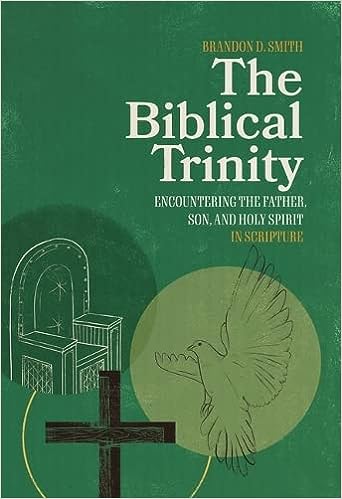A Book Review from Books At a Glance
by Ryan M. McGraw
Christians often struggle with the doctrine of the Trinity. Although the Trinity lies at the heart of the gospel and has always been central to the church’s confession of faith, the average believer often struggles with how to articulate it. To offset this issue, believers need more books on the Trinity that show them how to see and know God as Father, Son, and Spirit through Biblical examples. We know the Triune God better than we can define him. Brandon Smith’s short book wonderfully contributes to this task by highlighting four key Trinitarian ideas, showing people how to find them in the Bible itself, and helping them see the glory of the Triune God as the heart of the gospel of Jesus Christ. Making long strides towards this end, this book will particularly help people grasp the unity and progression of the Old and New Testaments in revealing the Father, through the Son, by the Spirit for the good of our souls.
In seventeen brief chapters, Smith gives readers a Trinitarian reading strategy, primarily through concrete examples of how the Triune God reveals himself in key texts (2). His material revolves around four key ideas: nature, relations, inseparable operations, and the hypostatic union (3-6). Respectively, these relate to what God is, to personal distinction within the Godhead, to how God works as a result, and to how Jesus’ incarnation reveals the Triune God. The advantage of including the last of these four points is that it is impossible to grasp Trinitarian theology in isolation from the doctrine of Jesus’ two natures (5), especially since many NT texts reveal God through both Christ’s deity and humanity.
Having written his doctoral dissertation on the Trinity in the Book of Revelation (published by IVP), the author wrote this book to mediate profound Trinitarian theology to the average Christian. Though the work has very few endnotes and citations, great learning in catholic trinitarian thought lies beneath the surface. One great strength of this book is that the author makes a “canonical argument” for the Trinity as it unfolds naturally through the whole Bible (105). Rather than a piecemeal approach treating one God, three persons called God, and maintaining personal distinction between them (which is good), Smith illustrates the natural way in which the OT culminates in the NT doctrine of the Trinity by focusing on key NT texts (which is better). The end result is that readers can begin to see Trinitarian patterns in the Bible itself. The final chapter (ch. 17) helpfully gives readers three guidelines for reading the Bible in a Trinitarian way: focus on Christ, trust the Spirit to give understanding, and learn to read using Trinitarian grammar (158-163).
One useful feature of each chapter is that the author begins ordinarily with the OT background of each passage treated, transitioning naturally from OT shadows to NT realities, revealing the Trinity ultimately through the person of Christ. Chapter ten’s focus on the confession of Jesus as Lord in 1 Corinthians 8:6 as a new “shema” illustrates how Smith does this brilliantly. In the Shema (Deut. 6:4), God called Israel to hear and believe that the Lord is one (90; “shema” meaning “hear” in Hebrew, which is the first word of this verse). The 1 Corinthians text places Jesus in the category of Creator with the Father as the “one God” (91). The Shema thus takes on a fuller meaning through the incarnation, death, and resurrection of God the Son (92), leading us to know the one God more fully as three persons. This chapter showcases how profoundly OT revelation of God transitions seamlessly and gloriously into the full NT doctrine of God, revolving around Jesus himself.
Although this book is a simple introduction to the Trinity, perhaps it is both oversimplified and overcomplicated at points. On the one hand, Smith bypasses some key Trinitarian ideas and terms. For instance, learning what it means for the Father to be God of none, the Son to be God of the Father, and the Spirit to be God of the Father and the Son explains a lot about why in Scripture God works from the Father, through the Son, by the Spirit. In this reviewer’s experience, pointing out patterns like this in Scripture, which draw people from God’s works back to God himself, has proved revolutionary for how they read the Bible. Additionally, key terms like “person” and “substance,” found in common Christian creeds, are underexplained. People need such terms, not only to understand the Bible, but get on the same page with the common expressions in the church’s long-standing teaching on the Trinity. On the other hand, he sometimes assumes and underexplains too much. For example, terms like monotheist (34), covenant (68), biblical canon (101), and defining what “hypostatic” means (117) may result in losing his target audience to some extent. Also, while “relation” is a vital term to explain personal distinctions within God, “person” has stuck and requires fuller explanation. While the book is solid, and rests on sound learning, including such features would make it more user-friendly to its target audience.
The Biblical Trinity delivers what it promises: seeing Trinitarian patterns in Scripture itself. As Smith notes well, “The doctrine of the Trinity is a call to worship, not a call to decoding theological facts” (27). Setting the right tone for Trinitarian theology, he invites readers to see the unity of God’s revelation from the OT to the NT, revolving around God’s self-revelation in Christ. Though his book will not give readers all that they need, Christians need books like this one as they seek to marvel at, worship, and rejoice in our great Triune God.
Ryan McGraw
Greenville Presbyterian Theological Seminary
